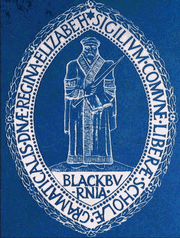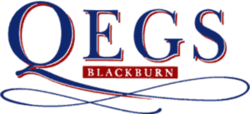Queen Elizabeth's Grammar School, Blackburn
Coordinates: 53°45′11″N 2°29′46″W / 53.753°N 2.496°W
 | |
| Motto |
Disce Prodesse (Loosely translated as "Learn to be of service") |
|---|---|
| Established | 1509 |
| Type | Free school |
| Religion | Church of England |
| Headmaster | Claire Gammon (acting) |
| Founder | Thomas Stanley, 2nd Earl of Derby |
| Location |
West Park Road Blackburn Lancashire BB2 6DF England |
| Local authority | Blackburn with Darwen |
| DfE number | 889/6001 |
| DfE URN | 141165 Tables |
| Ofsted | Reports |
| Students | 533 |
| Gender | Coeducational |
| Ages | 4–18 |
| Houses | 6 |
| Colours | |
| Publication | Q-news, Q-review |
| Former Pupils | Old Blackburnians |
| Website | www.qegsblackburn.com |
Queen Elizabeth's Grammar School (QEGS) is a co educational free school in Blackburn, Lancashire, England. Founded in 1509 as a boys' school, it is now a coeducational independent Free School with over 600 students from ages 4 to 18. Pupils come from a very wide geographical area, from Bolton to the south and to Colne in the east. It consists of an Infant School (Reception to Year 2), Junior School (Years 3 to 6), Senior School (Years 7 to 11) and Sixth Form.
The acting headteacher is Claire Gammon, replacing Simon Corns, who left the school in December 2016 to become the headteacher of Brighton College in Abu Dhabi.[1][2] He was appointed headteacher of QEGS in June 2006, and took over in September 2007.[3][4]

History
The school was founded in 1509, the first year of the reign of King Henry VIII, by Thomas Stanley, 2nd Earl of Derby, as a chantry school. It was situated adjacent to Blackburn Parish Church. The school survived the Reformation and in 1567 was granted a Royal Charter by Queen Elizabeth I. It thus became the “Free Grammar School of Queen Elizabeth in Blackburn in the County of Lancashire”.
In August 1819, the decision was taken to demolish the old parish church and rebuild it (the new church of St Mary the Virgin is now Blackburn Cathedral) and the school moved to a temporary home in nearby Market Street Lane until 1825. Its new site from 1825 was in the Bull Meadow area (“in the fresh air of the country”) but, as Blackburn itself expanded during the Industrial Revolution, the school there became too cramped.
In 1884, the Blackburn Grammar School, as it was then known, made one final move. The new site was on the west side of the town’s Corporation Park, close to Alexandra Meadows, the home of the East Lancashire Cricket Club and also the venue for a number of the early fixtures of the local football club Blackburn Rovers.
By the 20th century, the school was increasingly known as "Queen Elizabeth's Grammar School", its current name. It also began to outgrow its premises and began expanding. The Harrison Playing Fields at Lammack were opened in 1920. The junior department moved to its new premises known as "Horncliffe", which the junior school was known as for over half a century, and renovations on the "Big School" were completed in 1930.[5]
The school adopted independent status under the provisions of the Education Act of 1944 and later became a direct grant grammar school until the system was abolished in 1976. QEGS chose to revert to its independent status rather than join the state sector. In conjunction with the change of status, girls were accepted into the Sixth Form for the first time.
During the 1990s, QEGS was a participating school in the Assisted Places Scheme, which saw its pupil numbers grow dramatically. When the scheme was scrapped, the school administration was forced to limit its intake. In July 2001, coeducation was extended to all years.[6]
The Good Schools Guide described the students as "bright, industrious and confident without appearing complacent or alarmingly sophisticated."[7]
In November 2012, the school announced its intention to apply to become a free school by 2014.[8] In June 2017, the report from Ofsted determined the school "Requires improvement".[9]
Pastoral care
In February 2005, the School was commended (amongst other things) for the high standard of pastoral care offered to its pupils by the ISI inspection.[10] Q-Plus (Extended Hours Service) offers busy parents of Infant and Junior School pupils at QEGS a safe and secure environment for their children before and after the school day. The Breakfast Club runs from 7.45am each school day and children meet at the Q-Plus Club Room in Ormerod House on the Dukes Brow side of the site.
From here, they are escorted to Big School's the main dining hall to enjoy a range of breakfast options. After school, Q-Plus offers flexible collection arrangements, with children collected from the Infant School or Junior School and escorted back to the Q-Plus After-School Club.
House system
The system of houses was introduced at QEGS nearly one hundred years ago by then headmaster, Arthur Holden, and today there are six houses, each named after an Elizabethan sea captain.
The Arthur Holden Trophy is awarded each year to the House that has amassed the greatest number of points in various sporting events held throughout the year. Points towards the Marsden Merit Trophy are earned by way of credits for good, positive and helpful behaviour, as well as in teams in a range of “academic” activities, such as the keenly contested House Quiz, debating competitions and Maths Challenges.
Curriculum
The school has a strong track record of academic success, with nearly all pupils achieving the nationally recognised benchmark of at least five passes at GCSE grades A*-C, including English and mathematics. Over 70% of A level candidates typically obtain a place on their first choice course at their first choice university. In August 2011, it achieved a 100% passing rate in the A Levels.[11] It is one of the few schools which offers both GCSE and A Level Classics.
Sport
QEGS has also received a Sportsmark Gold award with Distinction for the school's outstanding commitment to sport and its links with local sports clubs. The QEGS 1st XI football team has won the Independent Schools Football Association Cup three times, more than any other team, the most recent victory coming in 2004.
Notable Old Blackburnians
- Ivor Bolton, conductor
- Robert Bolton, seventeenth century classical scholar & philosopher
- Richard Bowker CBE, formerly CEO, National Express Group
- Sir Harold Derbyshire, MC, QC, judge
- Christian Fraser, BBC foreign correspondent
- John Garstang, archaeologist, as well as author of A History of the Blackburn Grammar School published in 1897
- Krishnan Guru-Murthy, television presenter and journalist
- Russell Harty, television presenter and chat show host
- Wayne Hemingway, fashion designer
- Mick Jackson, author
- Sir Netar Mallick, professor of renal medicine
- Gordon Manley, climatologist.
- Sir Ernest Marsden, MC, nuclear physicist
- Frank Brian Mercer, inventor, director of Netlon.
- Prof. Julia Newton, Clinical Professor of Ageing and Medicine and Dean of Clinical Medicine at Newcastle University
- Michael Winterbottom, film director
- James Beattie, professional footballer
References
- ↑ "QEGS headteacher set for Abu Dhabi switch after overseeing major transformation". lancashiretelegraph.co.uk. 22 December 2016. Retrieved 11 April 2017.
- ↑ "'Significant moment' as 500-year-old Blackburn school appoints first female headteacher". lancashiretelegraph.co.uk. 28 December 2016. Retrieved 11 April 2017.
- ↑ "New man to head up QEGS". lancashiretelegraph.co.uk. 20 June 2006. Retrieved 11 April 2017.
- ↑ "New headteacher takes up reins at QEGS". lancashiretelegraph.co.uk. 5 September 2007. Retrieved 11 April 2017.
- ↑ About QEGS - History Archived September 26, 2012, at the Wayback Machine.
- ↑ "All change and here's to the girls!". Lancashire Telegraph. 6 July 2001.
- ↑ Good Schools Guide
- ↑ "QEGS announces plans to become a free school". November 2012.
- ↑ "QEGS, one of Blackburn's most prestigious schools has been told it 'requires improvement'". lancashiretelegraph.co.uk. 22 June 2017. Retrieved 26 June 2017.
- ↑ 2011 ISI Inspection Report
- ↑ "A-Levels: Queen Elizabeth's Grammar School". Lancashire Telegraph. 19 August 2011.
External links
- Profile on the ISC website
- ISI Inspection Reports
- Junior School Profile on Good Schools Guide